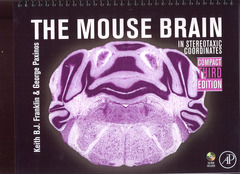Description
The Mouse Brain in Stereotaxic Coordinates, Compact (3rd Ed.)
The Coronal Plates and Diagrams
Authors: Franklin Keith B.J., Paxinos George
Language: English
Subjects for The Mouse Brain in Stereotaxic Coordinates, Compact:
106.54 €
Subject to availability at the publisher.
Add to cart
Publication date: 04-2008
256 p. · 21.5x27.6 cm · Spiral
256 p. · 21.5x27.6 cm · Spiral
Description
/li>Contents
/li>Readership
/li>Biography
/li>Comment
/li>
The Mouse Brain in Stereotaxic Coordinates is the most widely used and cited atlas of the mouse brain in print. It provides researchers and students with both accurate stereotaxic coordinates for laboratory use, and detailed delineations and indexing of structures for reference. The Compact 3rd edition is both a major revision and an expansion of previous compact editions. The 100 high resolution digital photographs of the coronal plane of section from the third full edition now complement the coronal drawings. The photographs of the sections and the intermediate sections are also provided on the accompanying CD. In addition, the compact version has a large introduction on stereotaxic surgery and the use of the atlas in the lab, as well as a number of panoramic simplified diagrams for student instruction. The Compact 3rd edition is in 8.5 x 11 format and is spiral bound suitable for positioning next to microscopes and cryotomes.
1. Introduction with student's guide on how to do stereotaxic surgery and how to use stereotaxic atlases
2. Introduction to the concept of neuromeres and brain development
3. Overview of the brain for students, including three sagittal, five coronal, and two horizontal simplified diagrams, as well as surface diagrams of the brain
4. Nomenclature ontology tree
5. 100 coronal diagrams and corresponding photgraphic plates
2. Introduction to the concept of neuromeres and brain development
3. Overview of the brain for students, including three sagittal, five coronal, and two horizontal simplified diagrams, as well as surface diagrams of the brain
4. Nomenclature ontology tree
5. 100 coronal diagrams and corresponding photgraphic plates
Standard neuroanatomy lab atlas for all labs doing neuroanatomy, neurophysiology, neuropharmacology, behavioral neuroscience, or molecular expression/cloning / neurogenetics in the mouse brain.
Dr. Franklin is Professor Emeritus at McGill University in the Department of Psychology. He is interested in neural mechanisms of motivation, particularly the role of specific neurotransmitter systems. His research uses pharmacological and molecular biological methods to study the role of monoamines, opiate peptides and neurosteroids in pain, memory and drug dependence.
Professor Paxinos is the author of almost 50 books on the structure of the brain of humans and experimental animals, including The Rat Brain in Stereotaxic Coordinates, now in its 7th Edition, which is ranked by Thomson ISI as one of the 50 most cited items in the Web of Science. Dr. Paxinos paved the way for future neuroscience research by being the first to produce a three-dimensional (stereotaxic) framework for placement of electrodes and injections in the brain of experimental animals, which is now used as an international standard. He was a member of the first International Consortium for Brain Mapping, a UCLA based consortium that received the top ranking and was funded by the NIMH led Human Brain Project. Dr. Paxinos has been honored with more than nine distinguished awards throughout his years of research, including: The Warner Brown Memorial Prize (University of California at Berkeley, 1968), The Walter Burfitt Prize (1992), The Award for Excellence in Publishing in Medical Science (Assoc Amer Publishers, 1999), The Ramaciotti Medal for Excellence in Biomedical Research (2001), The Alexander von Humbolt Foundation Prize (Germany 2004), and more
Professor Paxinos is the author of almost 50 books on the structure of the brain of humans and experimental animals, including The Rat Brain in Stereotaxic Coordinates, now in its 7th Edition, which is ranked by Thomson ISI as one of the 50 most cited items in the Web of Science. Dr. Paxinos paved the way for future neuroscience research by being the first to produce a three-dimensional (stereotaxic) framework for placement of electrodes and injections in the brain of experimental animals, which is now used as an international standard. He was a member of the first International Consortium for Brain Mapping, a UCLA based consortium that received the top ranking and was funded by the NIMH led Human Brain Project. Dr. Paxinos has been honored with more than nine distinguished awards throughout his years of research, including: The Warner Brown Memorial Prize (University of California at Berkeley, 1968), The Walter Burfitt Prize (1992), The Award for Excellence in Publishing in Medical Science (Assoc Amer Publishers, 1999), The Ramaciotti Medal for Excellence in Biomedical Research (2001), The Alexander von Humbolt Foundation Prize (Germany 2004), and more
- Delineations of 100 coronal diagrams, as fully revised for the third edition
- 100 coronal photographic plates produced from directly scanned very high resolution images of the biological sections (done at the Allen Institute)
- Beginner's guide with 25 pages on how to do stereotaxic surgery, how to use the atlas, including how to match experimental sections against the atlas plates (e.g. what features of the brain change gradually and can be used as guides to location)
- 3 sagittal, 5 coronal and 2 horizontal simplified overview diagrams for students
- Surface views of the brain with labels over the major structures
- Uses the best ontology tree (nomenclature based on the development of the brain) so far constructed with universal application across mammals
- CD providing electronic versions of all diagrams and photographs in different resolutions for downloads
© 2024 LAVOISIER S.A.S.




